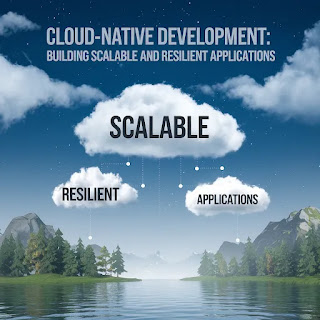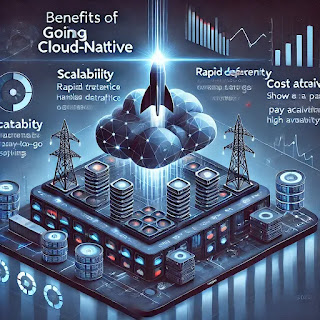Cloud-Native Development: Building Scalable and Resilient Applications.
Introduction: Why Cloud-Native Matters
Imagine launching an app that
suddenly goes viral. Overnight, your user base explodes—but instead of
celebrating, you’re scrambling to prevent crashes, slowdowns, and outages.
Traditional software architectures often buckle under such pressure. That’s where
cloud-native development comes in.
Cloud-native isn’t just about
running apps in the cloud—it’s a complete paradigm shift in how we design,
deploy, and scale applications. By leveraging modern technologies like
containers, microservices, and Kubernetes, cloud-native apps are built to be
scalable, resilient, and agile from the ground up.
In this article, we’ll break down
what cloud-native development really means, explore its core principles, and
show how companies like Netflix, Spotify, and Airbnb use it to handle millions
of users seamlessly.
What is Cloud-Native Development?
At its core, cloud-native development is about building applications specifically for cloud environments rather than adapting old, monolithic systems to fit. The Cloud Native Computing Foundation (CNCF) defines it as:
"Cloud-native
technologies empower organizations to build and run scalable applications in
modern, dynamic environments such as public, private, and hybrid clouds."
Key characteristics of cloud-native apps include:
·
Microservices
architecture – Breaking apps into small, independent services.
·
Containers
– Lightweight, portable runtime environments (e.g., Docker).
·
Dynamic
orchestration – Automated deployment and scaling (e.g., Kubernetes).
·
DevOps
& CI/CD – Continuous integration and delivery for rapid updates.
·
Resilience
& fault tolerance – Self-healing systems that minimize downtime.
Why Go Cloud-Native?
· Scalability – Automatically handle traffic spikes (e.g., Black Friday sales).
·
Faster
deployments – Push updates in minutes, not weeks.
·
Cost
efficiency – Pay only for the resources you use.
·
High
availability – Reduce downtime with automated failovers.
According to a 2023 report by
Gartner, over 95% of new digital workloads will be deployed on cloud-native
platforms by 2025—up from just 30% in 2021.
Key Pillars of Cloud-Native Development
1. Microservices:
Breaking Down the Monolith
Traditional apps are often
monolithic—a single, tightly-coupled codebase where a single bug can bring down
the whole system.
Microservices, on the other hand,
split the app into smaller, independent services (e.g., user authentication,
payment processing, recommendation engine).
Example:
Netflix runs over 500+
microservices to handle streaming, recommendations, and billing separately. If
one fails, the rest keep running.
2. Containers: The Building Blocks
Containers (like Docker) package
an app with all its dependencies into a single, lightweight unit that runs
consistently across any environment.
Why containers?
·
Portability
– Run the same app on your laptop, AWS, or Google Cloud.
·
Efficiency
– Use fewer resources than traditional virtual machines (VMs).
·
Isolation
– One crashing container doesn’t affect others.
3. Kubernetes: The
Orchestration Powerhouse
Managing thousands of containers manually is impossible. Kubernetes (K8s) automates deployment, scaling, and recovery.
How it works?
·
If a container fails, Kubernetes restarts it
automatically
·
If traffic spikes, it scales up containers, then
scales them back down when demand drops.
Case Study:
Spotify migrated to Kubernetes to
handle millions of concurrent streams while reducing cloud costs by 30%.
4. DevOps &
CI/CD: Speed Meets Reliability
Cloud-native thrives on
automation. DevOps practices + CI/CD pipelines (Continuous
Integration/Continuous Delivery) ensure rapid, error-free updates.
Example Workflow:
·
A developer pushes code → automated tests run.
·
If tests pass, the update is deployed to
production seamlessly.
·
Monitoring tools (like Prometheus) track
performance and roll back if issues arise.
·
Companies using CI/CD deploy up to 200x more
frequently than traditional setups (2022 DevOps Report).
Challenges & How to Overcome Them
While cloud-native offers huge benefits, it’s not without hurdles:
1. Complexity
Managing microservices, containers, and Kubernetes requires
expertise.
✅ Solution: Start small, use
managed services (e.g., AWS EKS, Google GKE).
2. Security Risks
More services = more attack surfaces.
✅ Solution: Implement zero-trust
security, service meshes (like Istio), and regular audits.
3. Observability
Debugging distributed systems is harder.
✅ Solution: Use tools like
Grafana, ELK Stack, or OpenTelemetry for real-time monitoring.
The Future of Cloud-Native
Cloud-native is evolving fast, with trends like:
·
Serverless
computing (AWS Lambda, Azure Functions) – Run code without managing
servers.
·
Edge
computing – Process data closer to users (e.g., IoT devices).
·
AI/ML
integration – Auto-scaling intelligent apps.
As Forrester predicts, by 2026,
85% of enterprises will prioritize cloud-native strategies to stay competitive.
Conclusion: Is Cloud-Native Right for You?
If you want scalability,
resilience, and speed, cloud-native is the way forward. Yes, the learning curve
is steep, but the payoff—faster innovation, lower costs, and happier
users—makes it worth it.
Whether you're a startup or an
enterprise, the question isn’t "Should we go cloud-native?" but
"How soon can we start?"
Ready to take the leap? Begin with a single microservice,
experiment with Kubernetes, and scale from there. The cloud is waiting. 🚀
What’s your biggest challenge with cloud-native? Let’s discuss in the comments!






